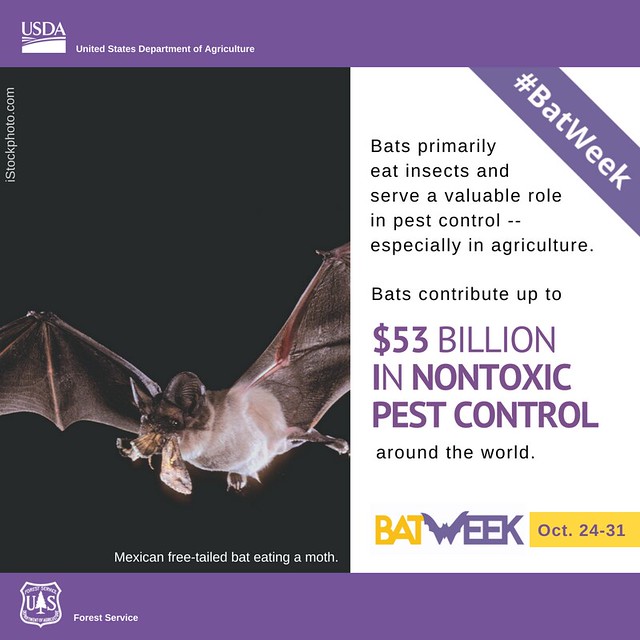
On August 10 of this year, USDA Secretary Sonny Perdue proclaimed (PDF, 1.3 MB) October 24 through 31 to be National Bat Week. The Secretary’s proclamation was followed by proclamations from the governors of West Virginia, Pennsylvania, Montana, and South Carolina.
Secretary Perdue’s proclamation cited bats’ unique role in controlling the pests that plague our homes, agriculture, and forests. It also recognized the growing threats to bats.
“Recent bat population losses from White-nose syndrome and other factors require attention to ensure the sustainability of our food production systems, avoid additional economic impact on the agricultural sector, and protect environmental health,” Secretary Perdue said in the proclamation.
Bats sustain our agricultural economy through important pest control, pollination, and other ecological benefits. These are common concerns among the many government, private-sector, and public organizations that celebrate and support Bat Week.

“Bats provide incredibly valuable ecosystem services to our society’s well-being. Many agricultural crops and native plants depend wholly or partially on bats to pollinate their flowers or spread seeds. Bats also help control damaging or bothersome insect pests,” said Rob Harper, national director for the Water, Fish, Wildlife, Air, and Rare Plants staff of the Forest Service. “Addressing the decline of bats across North America is one of the most important conservation efforts that private sector partners, the states, tribes, and federal agencies can agree to and work together on.”
These partnerships are essential in addressing habitat loss and White-nose syndrome, which is devastating bat populations. The USDA Forest Service is engaged in research of its own in tackling these problems. Right now, the agency is refining new methods of tracking bat populations over time.
“We are testing whether ultraviolet light can help control the fungus that causes White-nose syndrome,” said Patrice Klein, a veterinary scientist with the USDA Forest Service. “If that works in the lab setting, we will begin seeing how we can apply this in the field.”

Scientists like Klein are also bringing their expertise to partnerships like the North American Bat Monitoring Program, which standardizes and pools data from its extensive partner base to get a big-picture view of the state of bats in Canada, the United States, and Mexico.
The Forest Service also works with other agencies like the National Park Service to encourage safe practices to protect both people and bats, and to prevent the further spread of White-nose syndrome when visitors explore caves and other places bats might live.
You can learn more about how you can take part in Bat Week at batweek.org.




